This article will focus on a different series, a remake of the original 1991, known as “Dark (dark) shadows. Rebirth”) and the pilot version of 2004.
1. “Dark (dark) shadows. Rebirth” 1991
Screensaver of the new series in 1991
Twenty-one years after the release of the last episode of “Dark Shadows” and the film “Dark Shadows House”, director Dan Curtis entered into a partnership with the national broadcaster (NBC), now owned by General Electric, and jointly produced a new series , which aired as a big budget weekly program.
Moreover, Dan Curtis was persuaded to create it by the then head of programming, Brandon Tartikoff:
American television host Brandon Tartikoff, who served as president of NBC from 1980 to 1991.
Called “Rebirth”, this version of “Dark Shadows” retained the same gothic charm that made the original series so popular. This series was also produced by MGM Television.
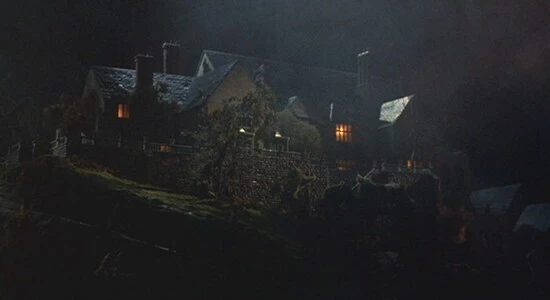
The program’s story structure reflected many key events from the original Dark Shadows’ 1967-1970 seasons, including a character who travels back in time to the 18th century (Victoria Winters, ed.) and another character’s accelerated aging (ie. Barnabas Collins).
Unfortunately, due to the outbreak of the First Gulf War, the series was often outpaced by news broadcasts, leading to constant rescheduling, viewer confusion, and ultimately low ratings for the series.
1991 series poster
The series has 12 episodes in total. I will say right away that this show is a mixture of the original series and several scenes from the 1970 House of Dark Shadows, which I will now show you.
This time, the real-life Greystone Mansion, also known as the Doheny Mansion, which is located in California, served as the filming location for the Collinwood estate and the basis for the exterior of the house:
This is what the Collinwood mansion looks like in the 1991 TV series
“The basic characters and relationships are the same,” Dan Curtis once said, “but what they do is different. I thought I could rely on these old scripts, but I found that they are full of crazy plots that we can’t use. Thus, all incidents are different; we come to the same points along a completely different route.
At first glance, at the beginning of the 1991 series, nothing much changes: Victoria Winters, with whom the original “Dark Shadows” actually began, is on a train to Collinsport.
In addition, the creator uses the same music by Robert Cobert for the opening sequence of the series and shows us the footage of the waves crashing on the rocks:
For comparison and clarity, I will show you how the original Dark Shadows series of 1966-1970 began:
The voice-over text that is spoken when Victoria arrives in Collinwood is also repeated.
It starts with “My name is Victoria Winters” and ends with “into a world I never knew, with people I’ve never met… People who are still just shadows in my mind today, but which will soon fill all the days and nights of my coming years.”
But let’s analyze each of the characters in this saga.
1. Victoria Winters
Sometimes it seems to me that the whole concept of “Dark (dark) shadows” cannot avoid the arrival of Victoria Winters in Collinwood, even when it is completely unnecessary.
These early stories created a number of problems for later interpretations of dark shadows, from 1970’s House of Dark Shadows to Tim Burton’s 2012 film.
With the exception, of course, of Night of Dark Shadows, where Quentin Collins and Angelica were one of the main characters, respectively, later interpretations of the original television series have sought to “reboot” the plot with the introduction of Barnabas Collins.
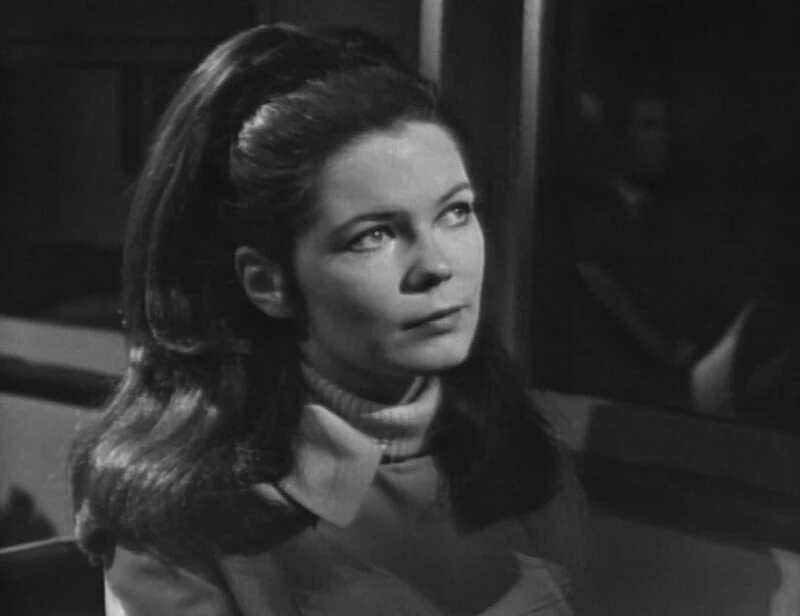
The problem facing the writers from the very beginning was this: What are you doing with Victoria Winters?
As in the beginning of the series, we see the image of a girl riding a train to a gloomy estate:
A still from the original Dark Shadows Victoria Winters (originally Sheila March) takes the night train to Collinsport to be the governess of David, the youngest son of an aristocratic family
What was so special about the romantic heroine of the original Gothic opera?
It was the mystery of her heritage, in particular her potential, unseen connection to the Collins family, that was the driving force behind the series…until a certain vampire knocked on the mansion’s front door.
Victoria later became a romantic backdrop for Barnabas Collins, but there was no question that she was usurped as the show’s protagonist.
Also, from the plot of the audio drama “Return to Collinwood” from the contents of Elizabeth Stoddard’s will, we learn that Victoria turned out to be her illegitimate daughter, and was invited to the house to be the governess of her restless son not just like that, but rather out of Elizabeth’s guilt before her, and in hope that the girl will become part of the Collins family, which subsequently happened.
Victoria attends a ball at Collinwood dressed as Josette Dupré. The series “Dark Shadows” 1991
And what do we see in this series (and in other adaptations)?
Victoria is not an orphan at all, or rather, we don’t really know anything about her parents and background. Only it says that Victoria lives in Boston, she is hired as a governess for David, as we hire tutors for our children.
Here, her secret of origin was discarded as unnecessary, but replaced with the theme of the reincarnation of the long-dead beloved of Barnabas Collins, the spiritual connection of girls through the centuries.
Whereas in the original it was Maggie Evans who was almost the twin sister of Josette, and only because of the external resemblance, consider that Barnabas became interested in her. But what is this love?
And Victoria, although outwardly she did not look like Josette, but possessed inner qualities similar to her. Not without reason, after all, in the original series, it was through her, and not Maggie Evans, that the restless ghost spoke during séances.
In this series, Victoria Winters is a character with no purpose and therefore lifeless. The biggest problem with using this heroine is that the writers have to combine two very different stories from the original gothic soap opera into one story.
One story tells us about the arrival of a governess in Collinwood in search of her lost family. It was the search for herself, her personality, ancient family ties that led Victoria to the gloomy Collinwood estate, and not just the position of governess.
Another is a horror story about a vampire released after 200 years of slavery in a coffin. Neither have anything in common other than the setting, and Barnabas’s romantic interest in a woman who, purely hypothetically, could be his relative adds a nasty layer of incest to the story…
But to use Victoria Winters by discarding her backstory is also pointless, because that backstory is the only thing that makes her interesting, as is, in fact, the whole movie.
Like her counterpart from episodes 366-460 of the original series, the 1991 version of Victoria is sent to Barnabas’s past due to a session with Sarah Collins…
And, on this, in fact, the series ends, and the further fate of the heroine after returning back is unknown.
2. Elizabeth Stoddard
Actress Jean Simmons as Elizabeth Stoddard
In this adaptation of the television series, Liz is no longer the good-natured woman. She is shown as a person of great pragmatism who is passionately devoted to her family.
Elizabeth was a leading force in the family business, but did most of her day-to-day business in Collinwood.
This version of Elizabeth Stoddard was an eccentric recluse known for her erratic behavior and avoidance of family drama.
If in the original series Elizabeth was almost Victoria’s mother, although she tried to hide it, then in the 1991 series she called the girl to only teach and re-educate her nephew David.
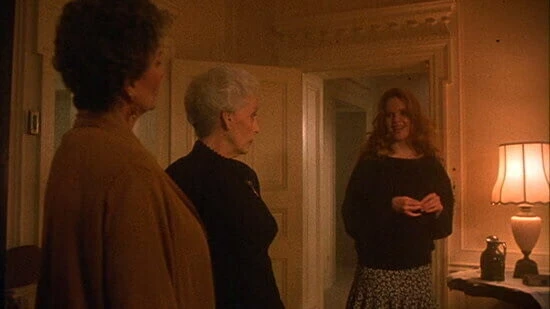
From left to right, the actresses: Jean Simmons as Elizabeth Stoddard, Julianne McCarthy as housekeeper Sarah Johnson and Barbara Blackburn as Carolyn Stoddard
Here is how the characters from the 1991 TV series talk about the arrival of the governess:
“Elizabeth Stoddard: It will be strange to have a stranger in the house.
Mrs. Johnson: I’m sure you made the right decision.
Caroline: You can say it again. I hope she brings a whip and a chair. It’s the only thing I haven’t tried with David.”
Actors Louis Edmonds as Roger Collins and Joan Bennett as Elizabeth Stoddard from the original 1966-1970s series
Now compare this to the very first episode of the original series:
Roger: “You’re standing at the window, looking out into the night, waiting for someone who shouldn’t have been invited here (Ask to come). Elizabeth, with all our skeletons in the closet, we don’t want strangers in this house! You don’t even know this girl… But after all, I’m your brother, and I’m only thinking about your own welfare. What is the need (why) to bring someone from New York to do something that we ourselves can do just fine?!
Elizabeth: Because I decided so! The girl will stay!
Roger: Wake up, Elizabeth! When a girl comes, give her a monthly salary and tell her to return to where she came from! And why don’t you open all the doors wide open and let the whole city into our house?!
Elizabeth: I asked Miss Winters to live here and she will stay!”
And so we see how different the attitude of Elizabeth from the original series to the arrival of Victoria from New York / Boston and its 1991 adaptation. Here she looks more like Roger.
3. Roger Collins
By the way, about Roger. In this adaptation, it is no longer his sister, but he himself who hires Victoria Winters for his son David. He also has a profession as an artist.
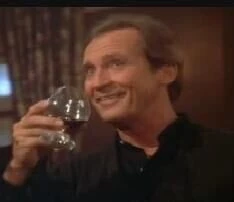
This character is shown in a more grotesque way than in the series. It’s not that he doesn’t love David, but he doesn’t recognize his son at all! And the character Burke Devlin, who was cut from this series, has nothing to do with it.
This is evident from an episode that was on the show, but for ethical reasons was not shown to the general public – how Roger explains that he resents David’s life, and adds that he would leave the boy to die in a burning room in order to save the woman’s sanity, which he did not recognize.
Unlike Roger from the original series, this character was divorced from Laura Collins after she was admitted to a psychiatric hospital and became romantically involved with Maggie Evans. Nothing more is known about him.
4. David Collins
In the 1991 version of “Dark Shadows” we are no longer an ordinary prankster and a bully, but a real juvenile bandit who only does what he does to disrupt classes with Victoria Winters and tries to do some dirty trick like “surprises” in the form of a dead bloody rat in a shoe box, a tarantula, and a burning voodoo doll in the shape of his father.
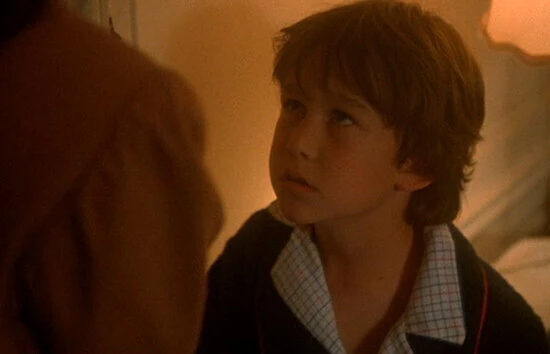
Actor David Hanesy as David Collins from the original “Dark Shadows” 1966-1970.
So, David Collins from episodes 4-5 says only two phrases to Victoria Winters: “I hate you!” and “The widows told me to send you home!” (Widows are the ghosts of women who committed suicide by jumping off a cliff because their husbands died at sea, ed.).
And here is how he met David Victoria Winters in the Old House, in the 1991 TV series:
“Victoria Winters: (about the old house) wouldn’t that be wonderful?
David: It will be terrible.
Victoria: We’ll be very good friends, David.”
From his backstory, we learn that the boy lived without a father for about 6 years and was transported to England by his aunt Elizabeth Stoddard when his mother went mad. Roger, apparently, did not attend to his son at all …
And yes, like the TV series David Collins, he is friends with the ghost of Sarah, Barnabas’ younger sister. And, if the original David Collins gradually softened as the 1966-1970 series progressed, then the 1991 version of David remained cruel, whether to relatives or to Victoria Winters.
I’m not sure that such an immoral and flawed character, as he is portrayed in these early episodes, had a future at all. David represented a protracted conflict rarely seen on television.
The birth of a child who is a psychopath/sociopath is a tragedy that keeps on giving and this version of David offered endless opportunity for drama…even after that, vampires became regular visitors to Collinwood.
I’d love to see this version of the character grow up and eventually take over the management of the estate. But the creators decided to do it differently. David inherited only the family business, and the house went to his sister Carolyn.
In the 1991 series, the characters do not change for the better. David, as he was hostile to everyone, remained so. Nothing is known about the further fate of the boy.
